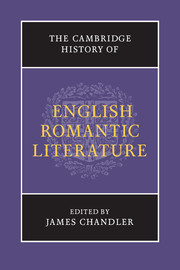Book contents
- Frontmatter
- Introduction
- Part I The Ends of Enlightenment
- Part II Geographies: The Scenes of Literary Life
- Part III Histories: Writing in the New Movements
- 15 Rebellion, revolution, reform: the transit of the intellectuals
- 16 Changes in the world of publishing
- 17 The new poetries
- 18 Romanticism and poetic autonomy
- 19 Transformations of the novel – I
- 20 Transformations of the novel – II
- 21 Theatre, performance and urban spectacle
- 22 The epigenesis of genre: new forms from old
- 23 The literature of the new sciences
- 24 The making of child readers
- Part IV The Ends of Romanticism
- Chronology
- Bibliographies
- Index
- 1 A New Pocket Map of the Cities of London and Westminster; with the Borough of Southwark, Comprehending the new Buildings and other Alterations, 3rd edn (London: William Faden, 1790).">
- References
17 - The new poetries
from Part III - Histories: Writing in the New Movements
Published online by Cambridge University Press: 28 May 2009
- Frontmatter
- Introduction
- Part I The Ends of Enlightenment
- Part II Geographies: The Scenes of Literary Life
- Part III Histories: Writing in the New Movements
- 15 Rebellion, revolution, reform: the transit of the intellectuals
- 16 Changes in the world of publishing
- 17 The new poetries
- 18 Romanticism and poetic autonomy
- 19 Transformations of the novel – I
- 20 Transformations of the novel – II
- 21 Theatre, performance and urban spectacle
- 22 The epigenesis of genre: new forms from old
- 23 The literature of the new sciences
- 24 The making of child readers
- Part IV The Ends of Romanticism
- Chronology
- Bibliographies
- Index
- 1 A New Pocket Map of the Cities of London and Westminster; with the Borough of Southwark, Comprehending the new Buildings and other Alterations, 3rd edn (London: William Faden, 1790).">
- References
Summary
‘What’s new?’
Something, anyway, was stirring. Whether polemical ‘experiment’, flaunted ‘innovation’ or coded ally of political ‘liberty’, a new poetry was refusing imposed or inherited forms as tyranny, as strictures of outworn prestige, institution or just plain old bad habit. The signs were everywhere. ‘I must Create a System, or be enslav’d by another Mans’, declared Blake’s Los (Jerusalem, plate 10). If Dryden argued that rhyme and metrical law were necessary to put ‘bounds to a wilde over-flowing Fancy’, Wordsworth, though hewing to metre and often rhyme, recoiled from ‘the bondage of definite form’. He went so far as to equate ‘all good poetry’ with ‘the spontaneous overflow of powerful feelings’. This last axiom is from his Preface to the second, signed edition of Lyrical Ballads (1800), a document that declared a refusal of ‘known habits of association’ in the production of and judgements about poetry. Looking back in 1817, Coleridge marked a watershed in Wordsworth’s ‘awakening the mind’s attention from the lethargy of custom’ and from ‘the film of familiarity’ – not only in modes of perception, but in the very excitement of poetic events. Shelley would soon raise the stakes in A Defence of Poetry, celebrating the power of poetry to transform everything within and without: poetry ‘strips the veil of familiarity from the world’ and, in correspondence, ‘purges from our inward sight the film of familiarity which obscures from us the wonder of our being’.
Keywords
- Type
- Chapter
- Information
- The Cambridge History of English Romantic Literature , pp. 403 - 426Publisher: Cambridge University PressPrint publication year: 2009



